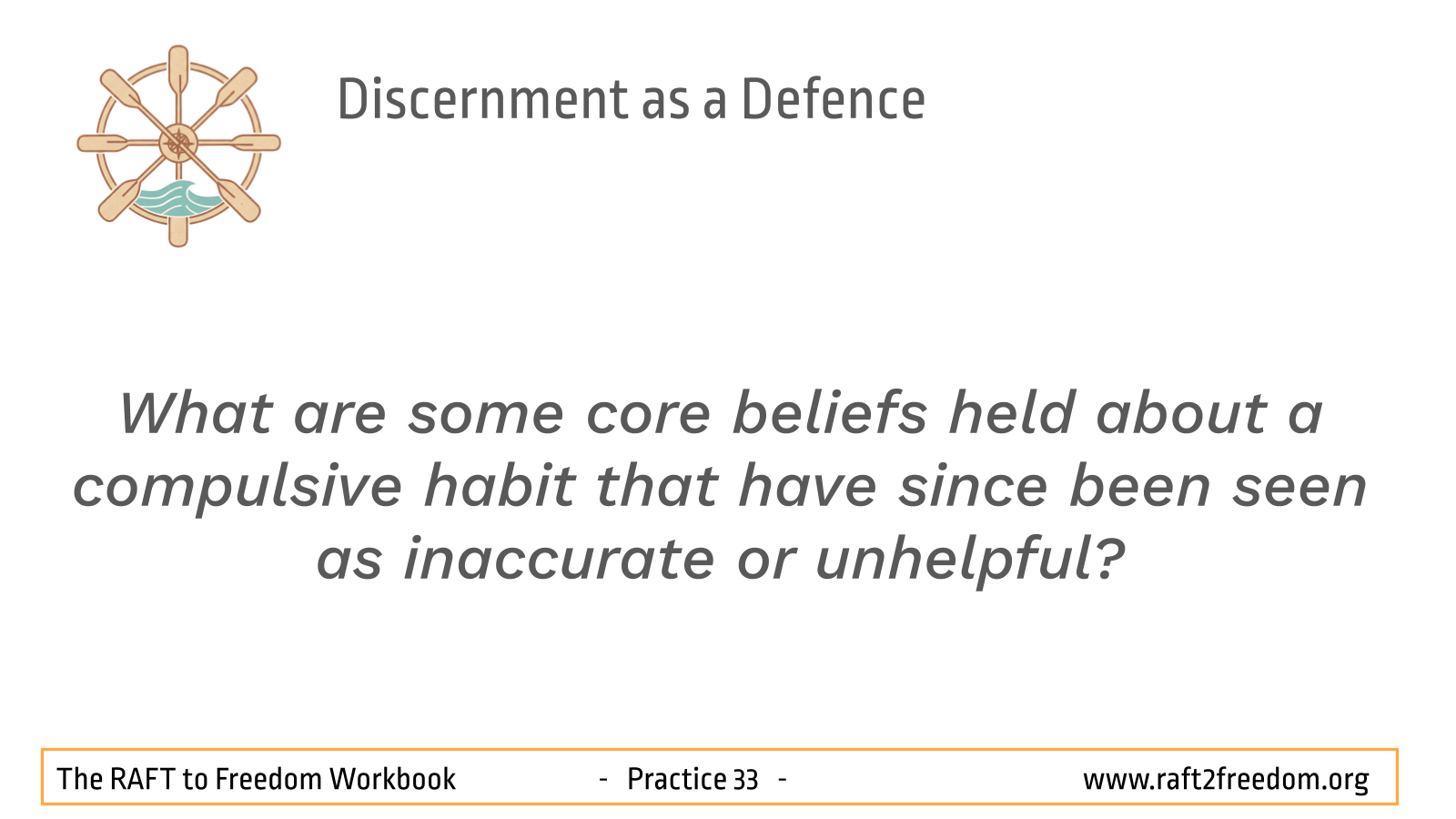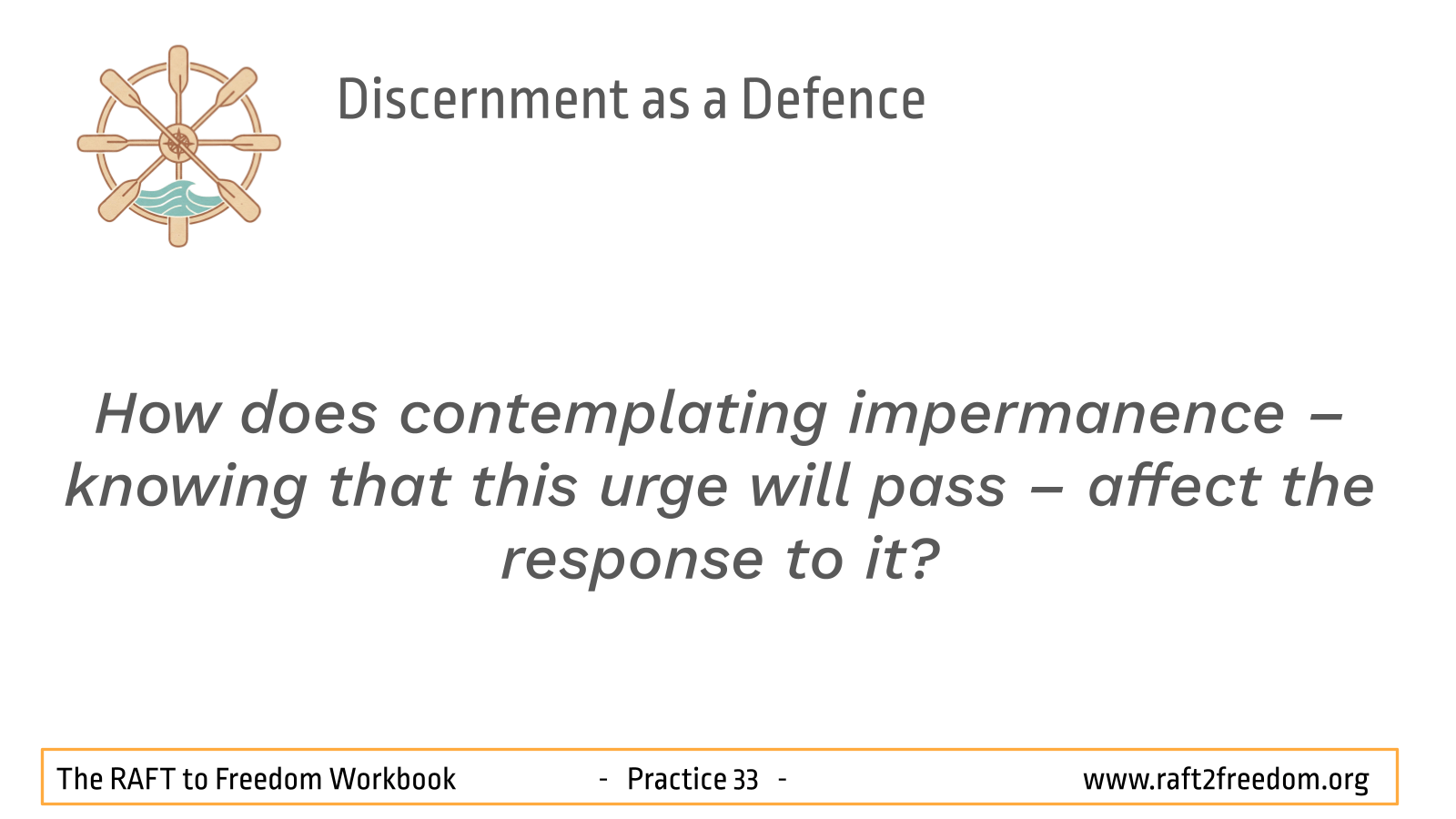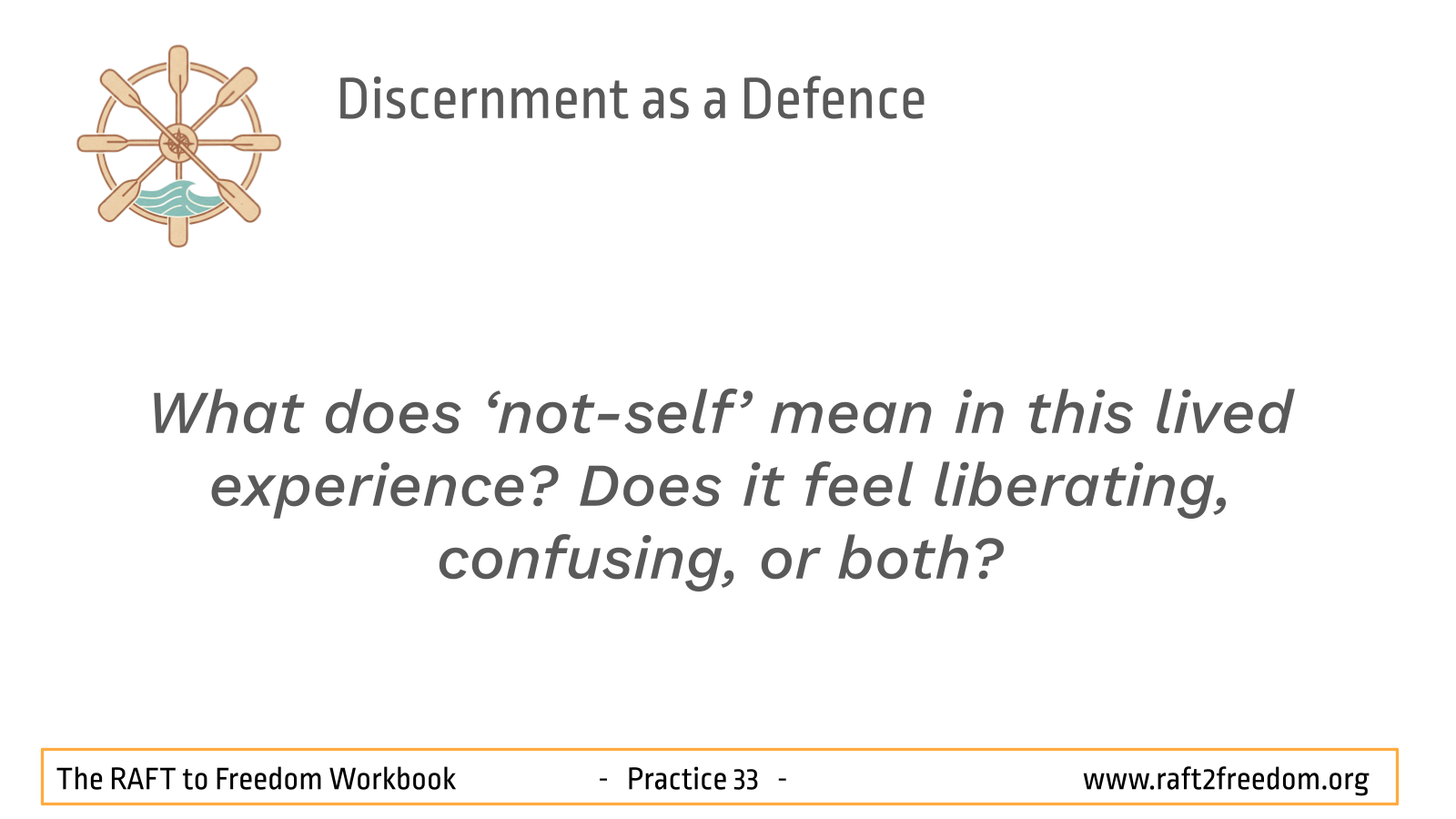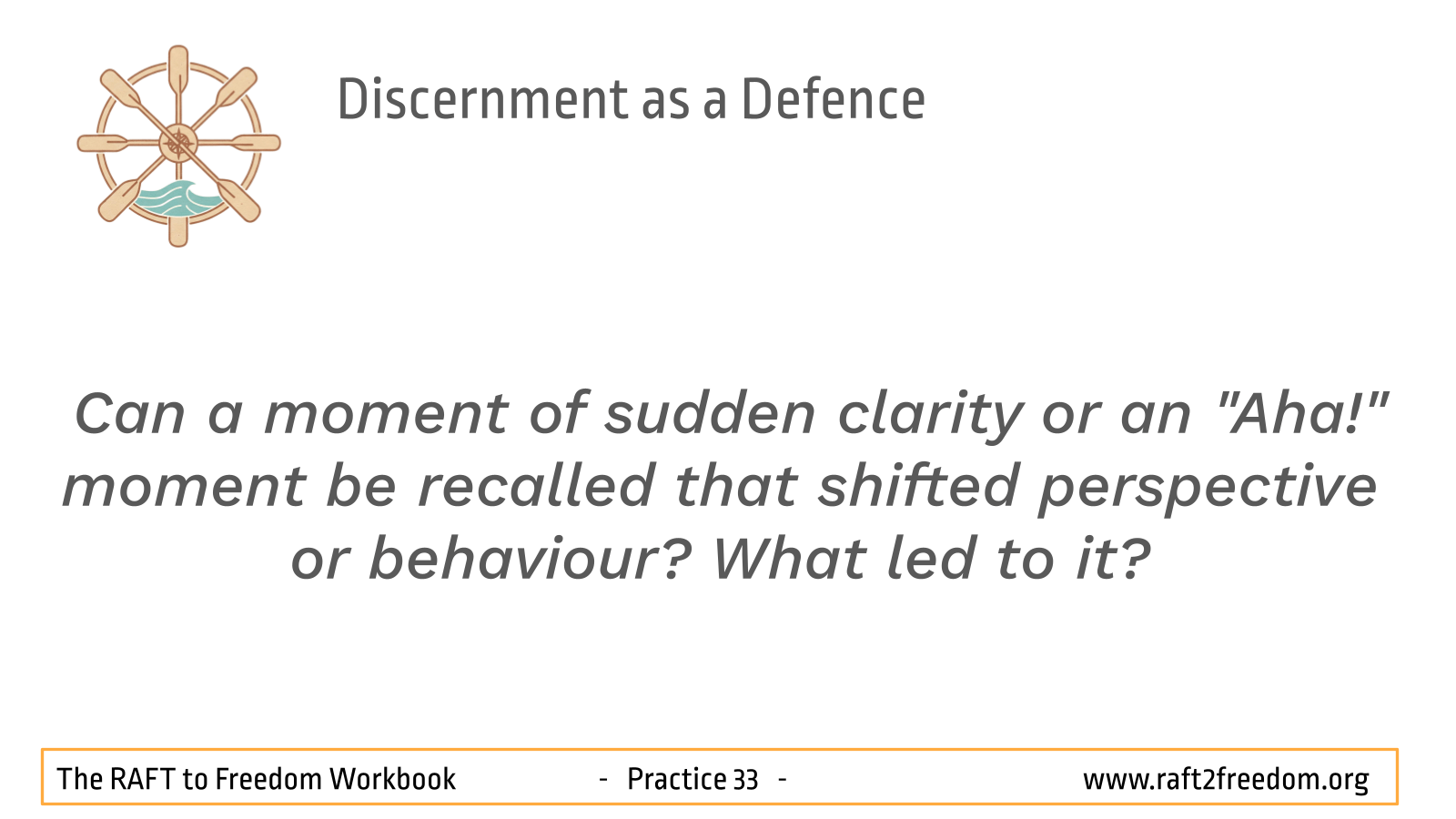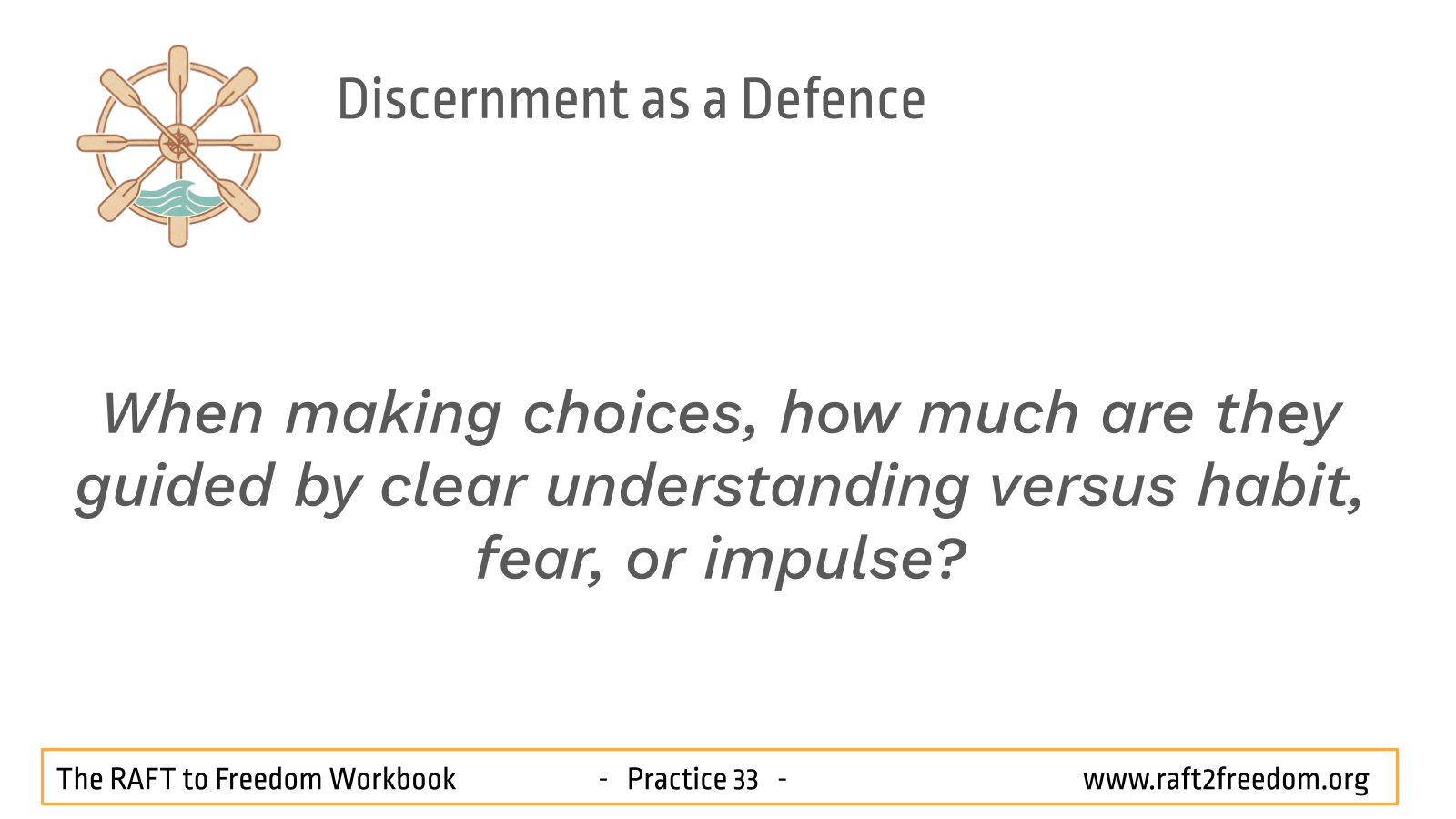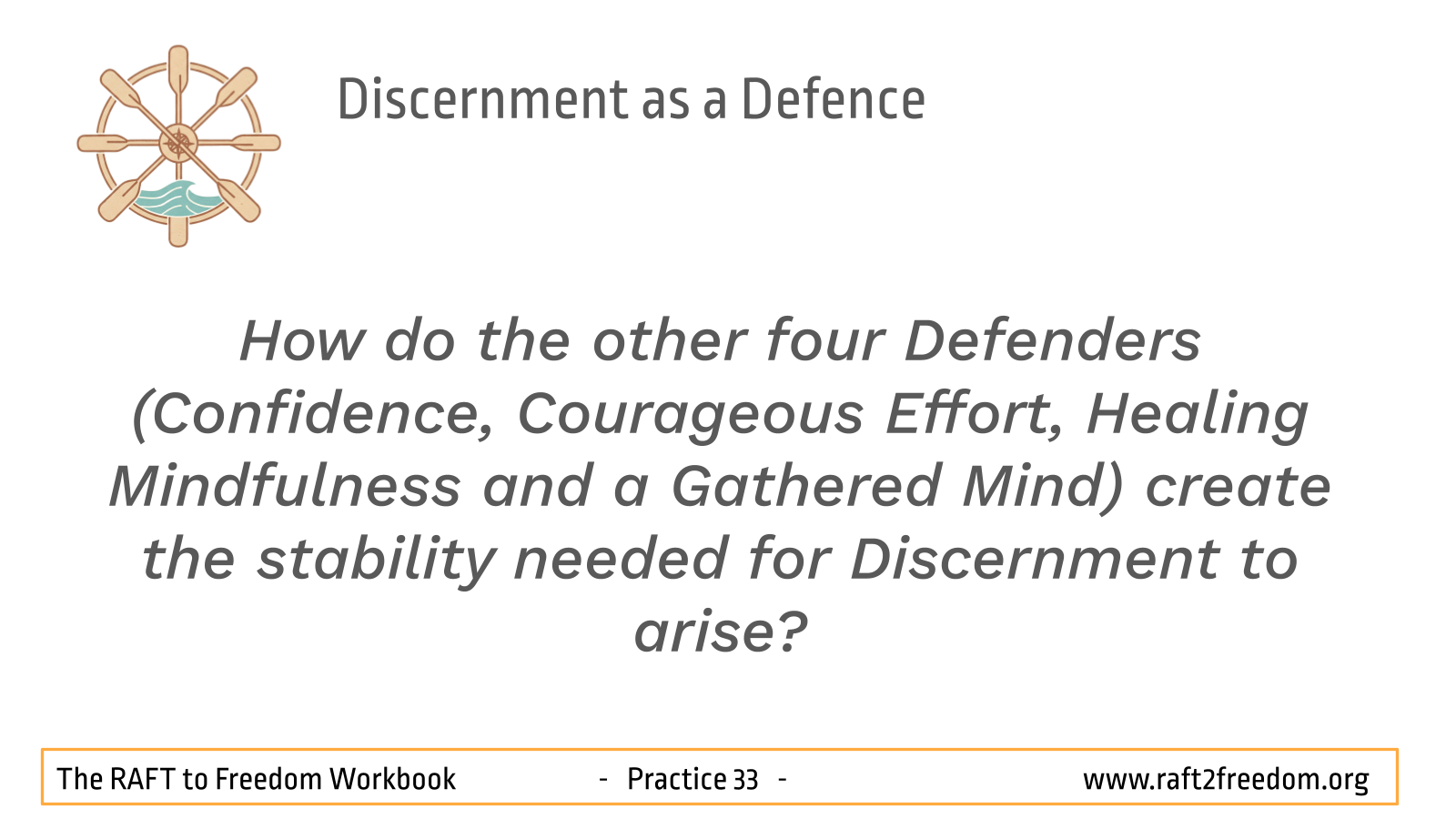33: Discernment as a defence
Just as a surgeon uses a sharp knife to remove a poisoned arrow, so too wisdom cuts away ignorance.
adapted Gotama (the Buddha)
‘The measure of intelligence is the ability to change.’
Albert Einstein
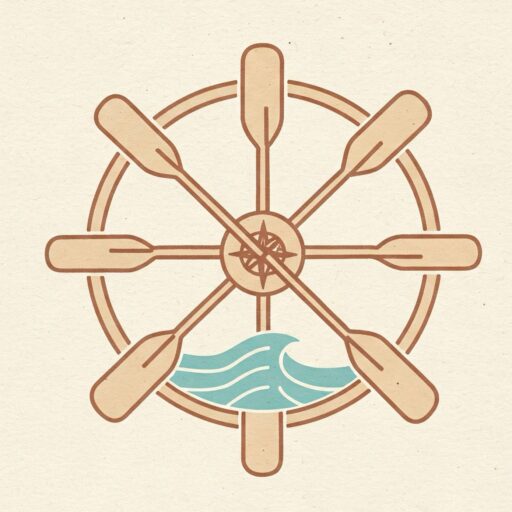
Episode 33: Discernment as a defence
An AI generated ‘deep dive’ into this aspect of the RAFT to Recovery
The wisdom that frees
We arrive now at the fifth and culminating Defender of Freedom: ‘Discernment’, known in Pāli as paññā. This is the faculty of wisdom, insight, and clear understanding that integrates and guides all the other defenders. Confidence provided the trust, Courageous Effort the energy, Healing Mindfulness the awareness, and a Gathered Mind the stability. Discernment is the intuitive understanding that arises from this stable, mindful attention, allowing us to see things as they truly are and cut through the delusions that fuel our harmful patterns and suffering.
In the ‘RAFT to Freedom’ metaphor, Discernment is the wisdom of the Navigator. The Navigator interprets the ‘charts’ (the teachings), reads the actual conditions of the sea (direct experience), and decides the correct direction to steer the raft, ensuring the journey proceeds toward the safe shore of freedom.
This wisdom is not merely intellectual knowledge; it is direct, experiential insight. It is the direct antidote to ignorance and delusion, the root causes of our harmful compulsions. Craving thrives on illusion: the illusion that urges will last forever, that acting on them will bring lasting satisfaction, or that a fixed ‘I’ must obey their commands. Discernment dismantles these illusions by clearly seeing three characteristics of being:
- Impermanence: Urges, thoughts, and feelings are recognised as transient waves. Knowing “this too will pass” weakens their power.
- Unsatisfactoriness: Lived experience reveals that harmful patterns never provide lasting peace, thereby undermining their appeal.
- Not-Self: Urges are seen as impersonal, conditioned events, not the commands of a fixed ‘self’. This loosens the grip of identification and self-blame
Discernment is the force that allows us to abandon cravings and aversions, not through brute force, but through a profound and liberating understanding of their nature and consequences – “ Mara – I see you”.
The different flavours of wisdom
Discernment is not a single event but a quality that deepens and evolves. The path shows how it progresses from received knowledge to embodied insight, and from a guiding principle to a dynamic, investigative tool.
The three sources of wisdom
Wisdom matures through a progressive sequence:
- Learning: This is the wisdom gained through study, reading teachings, or listening to wise people. It is the essential map for our journey.
- Reflection: This involves thinking about what has been learned, questioning its meaning, and reflecting on how it applies to our own experience. It turns the map’s information into a personal understanding.
- Cultivation: This is embodied wisdom that arises from meditation and lived experience. It is wisdom that is known in our bones, integrated so that we live from a place of deep knowing.
The progressive development of discernment
In Gotama’s teaching, Discernment is not a single insight but a living faculty that evolves through practice. This progression can be traced across five of Gotama’s 37 ‘Liberating Practices’, his core curriculum. Each presents wisdom in a slightly different role – as a principle to be practiced, a faculty to be developed, a power to be mastered, and a quality to be applied dynamically in investigation and as an appropriate perspective.
At every stage, wisdom functions as the mind’s natural intelligence: the ability to discern what leads toward freedom and what leads away from it. The more it is cultivated, the less it depends on belief or effort; wisdom becomes self-sustaining, like a lamp that continually lights its own flame.
The following overview outlines how wisdom appears and matures across five key frameworks – from the Middleway to the Seven Supports – showing how each phase refines and strengthens our capacity for clear seeing. Across these frameworks, wisdom develops in a clear progression:
- Fearless investigation: As one of the Four Superpowers, Fearless Investigation represents the intellectual and intuitive curiosity that fuels the development of concentration and insight. It functions as a foundational component that sustains engagement and focus in practice.Investigation at this stage involves questioning, exploring, and examining the teachings experientially – a process that sharpens attention and nurtures understanding. It is the energy of inquiry that keeps the mind awake and directed toward truth. (Chapter 24)
- Faculty of wisdom: Within the five faculties, the faculty of wisdom appears as a developing quality of mind that actively counters ignorance and confusion. It functions as a developing skill – a growing sensitivity to what is wholesome, skilful, and true. Because it is still maturing, this faculty must remain balanced with confidence, so that analysis does not become scepticism and faith does not slide into blind belief. At this stage, wisdom is learning to discern and verify experience through practice rather than through theory alone.
- Power of wisdom – Discernment: When the faculty of wisdom matures, it becomes one of the Five Defenders. Here wisdom is an intrinsic, unshakeable strength that can no longer be disturbed by ignorance. It functions as a mastered strength, insight so stable and embodied that it naturally guides thought, speech, and action. At this level, Discernment no longer needs conscious protection; it has become the natural governing force of the mind, illuminating reality clearly even under pressure.
- Focused Investigation: Within the ‘Seven Supports’ Focused Investigation as an energising factor that actively awakens insight. It functions as a responsive catalyst, applied tactically whenever dullness, lethargy, or confusion arise. By encouraging mindful exploration of experience, Focused Investigation invigorates the mind and opens the door to understanding the nature of the ‘Five Hindrances’ and how to overcome them. At this advanced stage of development, investigation no longer seeks information; it directly reveals wisdom through continuous, curious awareness. (Chapters 37 to 50)
- Appropriate Perspective: In Gotama’s fourth realisation – the ‘Middleway’ – Discernment provides the foundational conceptual framework that guides the entire journey to liberation. It functions as the guiding principle of the journey, orienting all other practices toward ‘Recognising’ life’s pain, difficulties and disappointments, ‘Abandoning’ harmful cravings, compulsions and confusion, resting in the resulting ‘Freedom’ and the ‘Training’ that leads to the ‘safe shore’. At this stage, Discernment is emerging as foundational understanding: the capacity to see clearly and correctly interpret the nature of life’s challenges.
In this way, discernment is both the first step and the final fruition of the journey – the ever-deepening clarity that both illuminates and liberates the mind.
How to cultivate Discernment
Wisdom doesn’t arise by accident; it is cultivated through specific practices grounded in mindfulness and concentration.
- Pause for the wise question: In moments of choice, ask: “What leads away from harm? What serves well-being?”. This simple inquiry, central to Gotama’s advice to his son Rahula, is the heart of ethical discernment.
- Mindfully investigate experience: When a craving arises, look at it with curiosity. Where is it felt in the body? What is its quality? Watch it change. Is it constant or temporary? Is it truly satisfying ? Is there a solid ‘I’ demanding this, or is it an impersonal process?
- Challenge deluded thinking: Recognise and deconstruct the justifications that support harmful patterns. When the thought “Just one more” arises, challenge it: “Is this really true? What happened last time?”. In many modern recovery models, this is known as ‘rolling the tape’ – playing the story forward to its real consequences, not its fantasised relief.
- Observe cause and effect: Pay close attention to the link between choices and their consequences. This experiential understanding powerfully reinforces wise decisions and weakens the appeal of unskilful ones.
- Practise compassionate clarity: Remember that discernment is not harsh self-judgement but gentle, clear seeing. It is the ability to recognise error without condemnation, always pointing the way toward a wiser, kinder choice.
Self-reflections
- What are some core beliefs held about a compulsive habit that have since been seen as inaccurate or unhelpful?
- How does contemplating impermanence – knowing that this urge will pass – affect the response to it?
- What does ‘not-self’ mean in this lived experience? Does it feel liberating, confusing, or both?
- Can a moment of sudden clarity or an “Aha!” moment be recalled that shifted perspective or behaviour? What led to it?
- When making choices, how much are they guided by clear understanding versus habit, fear, or impulse?
- What conditions – inner or outer – best support the arising of Discernment?
- How do the other four Defenders (Confidence, Courageous Effort, Healing Mindfulness and a Gathered Mind) create the stability needed for Discernment to arise?
Journaling prompts
- Applying the three characteristics of being: Choose one specific aspect of a recurring pattern (for example, a particular craving or aversion, a thought, a sensation). Reflect and write about it through the lens of ‘Impermanence’ (Is it permanent?) ‘Pain, difficulty and disappointment’ (Is it truly satisfying?), and ‘Not Self’ (Is it ‘me’ or ‘mine’?).
- Deconstructing a justification: Identify one common thought that arises with an urge (for example, “I deserve it,” “It helps me cope”). Write it down, then challenge it with wise investigation. What are the hidden assumptions? What are the real consequences?.
- Cause and effect log: For a day, pay close attention to the link between specific actions and the resulting mental/emotional states. Note these connections. What patterns emerge?
- Defining wisdom: What does ‘wisdom’ mean to you on this journey?. Write about someone you consider wise – what qualities do they embody and how could those be cultivated?
- A moment of clarity: Describe a time you saw through an illusion about a compulsive behaviour. How did that insight feel in the body and mind? How did it shift your actions?
- The navigator’s log: Journal about a time when Discernment acted as your navigator, guiding you through a storm of craving, aversion or a difficult emotion. What ‘charts’ (teachings) or ‘weather conditions’ (direct feelings) did it use?
- Compassion and discernment: Reflect on how being kind to yourself affects your ability to see clearly. What does it feel like to see a mistake without the cloud of self-judgement?
Supporting material: scientific and philosophical perspectives
For those interested in the scientific and philosophical underpinnings of Discernment as a Defence, the following overview highlights some key connections.
- Neuroscience: Insight experiences are linked to integrated brain activity, particularly involving the anterior cingulate cortex and temporal lobe. The capacity for cognitive reappraisal – reframing the meaning of urges and choices—relies on the prefrontal cortex (PFC) to modulate emotional responses from the amygdala. Regular practice strengthens these circuits, making wisdom more accessible.
- Psychology: Cognitive Behavioural Therapy (CBT) is a direct application of discernment, as it works by identifying and challenging the distorted thinking that fuels harmful behaviours. Acceptance and Commitment Therapy (ACT) cultivates ‘defusion’ – the ability to see thoughts as just thoughts, not commands – which is a core function of wisdom. The practice of ‘rolling the tape,’ common in 12-step models, is an act of discernment, challenging the mind’s fantasy of a positive outcome by recalling the predictable, negative consequences of past actions.
- Philosophy: Discernment is central to the search for truth and ethics. Stoicism emphasised distinguishing between what is within our control (our judgements and intentions) and what is not – a clear parallel to Buddhist wisdom. In Buddhist philosophy, paññā is the crown of the path, the direct insight into Gotama’s life changing realisations and the three characteristics of being that transforms all other faculties into factors of liberation.
Remember to remember
Discernment (paññā), cultivated into the strength of wisdom, is the fifth and culminating Defender. It is the clear seeing that cuts through the illusions sustaining craving and aversion, liberating us not by force but by understanding. This liberating insight illuminates why letting go leads to freedom, arising from a foundation of Confidence, energised by Courageous Effort, observed by Healing Mindfulness, and stabilised by a Gathered Mind. As the Navigator, Discernment uses the wisdom gained from the journey to guide our raft accurately and safely to the far shore.
Remember that wisdom is not just found in grand, transformative insights, but is present in small, daily acts of clarity. Each time you pause to ask, “What leads away from harm?” and follow that wise answer, you are cultivating Discernment. In the surgeon’s simile, Healing Mindfulness is the probe that finds the splinter, Discernment is the sharp knife that removes it, Courageous Effort is the steady hand, a Gathered Mind stabilises the body, and Confidence the trust that healing is possible. It is this clear-seeing wisdom that finally sets us free.
Wisdom begins in wonder.
Socrates
Discernment is not about knowing everything, but about knowing what matters most.
Howard Thurman
Sutta references
- Sammādiṭṭhi Sutta (MN 9) – Right View
- Summary: Defines Right View (the beginning of discernment) as the understanding of wholesome and unwholesome roots, The Four Realities, and other core doctrines, showing the content of liberating wisdom.
- Anattalakkhaṇa Sutta (SN 22.59) – The Characteristic of Not-Self
- Summary: The Buddha analyses the five aggregates (form, feeling, perception, fabrication, consciousness), demonstrating that because they are impermanent and unsatisfactory, they cannot be regarded as ‘self’. Understanding this leads directly to dispassion and liberation.
- Ambalaṭṭhika Rāhulovāda Sutta (MN 61) – Advice to Rahula
- Summary: Gotama instructs his son, Rāhula, to use reflection as a mirror for his actions. Before, during, and after any act of body, speech, or mind, he is to reflect: “Does this lead to harm for myself or others?”. This is a direct and practical guide to cultivating ethical discernment in daily life.
| RAFT to Freedom © 2025 by Dr Cathryn Jacob and Vince Cullen is licensed under CC BY-NC-SA 4.0. To view a copy of this license, visit https://creativecommons.org/licenses/by-nc-sa/4.0/ |

